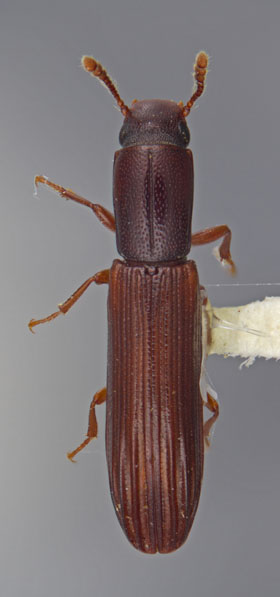 |
 Previous Genus Next Genus Previous Genus Next Genus 
Genus: Colydium
Diagnostic Features
- Description: Body elongate, subcylindrical. Antennae 11-segmented with a 3-segmented club. Antennal setation sparse. Subantennal grooves absent. Eyes ovate, well-developed, coarsely faceted. Eyes weakly to distinctly emarginate anteriorly by projection of frons, forming a distinct canthus. Pronotum subquadrate to elongate. Pronotal disc often with pair of sublateral sulci and single medial sulcus. Procoxal cavities narrowly closed. Metacoxae narrowly separated, separation less than metacoxal length. Tarsal formula 4-4-4. Apex of protibia expanded, armed with a stout, apical spine. Dorsal surface glabrous, moderately shiny.
- Similar genera: The genus Colydium is superficially similar in general appearance to Aulonium. The non-carinate elytral declivity and absence of a pair of long setae near the apical margin of the last abdominal ventrite serve to distinguish Aulonium. The genus Phloeonemus also has emarginated eyes formed by a projection of the frons, but is readily distinguished from Colydium and Aulonium by the 2-segmented antennal club, lack of a stout apical spine on the protibia, explanate lateral pronotal margins, very different sculpturing of the pronotal disc.
Known Distribution
- Northwest (ID, MT, OR, WA), Southwest (AZ, CA, CO, NM, NV, UT), North Central (SD, IL, IN, MI, OH), Northeast (DC, DE, NJ, NY, MA, MD, PA, WV, VA), Southeast (AL, FL, GA, KY, NC, SC, TN), South Central (AR, LA, MS, OK, TX) USA, and British Columbia, Canada.
Biology
- Colydium has been collected at MV/UV lights and from under the bark of various dead hardwoods and conifers. Adults and larvae of Colydium have been found in the galleries of scolytine weevils (Curculionidae), and they are suspected to feed on the larvae of those beetles within the galleries (Ivie, 2002; Lawrence, 1991; Wegrzynowicz, 1999). It is unclear whether or not this genus can be considered beneficial, as the feeding on wood boring beetles may be circumstantial.
- Abundance: Moderately common.
North American Species (5)
Species Diagnoses
- Colydium glabriculum: Apex of clypeus glabrous, labrum distinctly setose. Anterior angles of pronotum rounded, not projecting forward. Lateral margins of pronotum narrowing basally. Sublateral sulci of pronotal disc distinct. Elytral carinae distinctly raised basally and for apical half, indistinctly raised medially. Body reddish, apex of elytra darker. Distribution: Arizona and New Mexico, USA.
- Colydium lineola: Body 5x longer than wide. Apex of clypeus and labrum both distinctly setose. Anterior angles of pronotum rounded, not projecting forward. Lateral margins of pronotum narrowing basally. Sublateral sulci of pronotal disc faint to absent. Elytral carinae distinctly raised for entire length. Body dark red to black. Distribution: Washington D.C., Delaware, Illinois, Indiana, Maryland, New Jersey, New York, Pennsylvania, Alabama, Arkansas, Florida, Georgia, Louisiana, Mississippi, South Carolina, Tennessee, Arizona, California, Oklahoma, Texas, Oregon, Washington, Missouri, USA; British Columbia, Ontario, Canada.
- Colydium nigripenne: Apex of clypeus and labrum both distinctly setose. Anterior angles of pronotum rounded, not projecting forward. Lateral margins of pronotum narrowing basally. Sublateral sulci of pronotal disc distinct. Elytral carinae distinctly raised for entire length. Head and pronotum reddish, elytra black. Distribution: Washington D.C., Maryland, Illinois, New Jersey, Alabama, Arkansas, Florida, Georgia, Mississippi, North Carolina, South Carolina, Tennessee, Oklahoma, Texas, USA.
- Colydium robustum: Body 4x longer than wide. Apex of clypeus and labrum both distinctly setose. Anterior angles of pronotum angulate, distinctly projecting forward. Lateral margins of pronotum evenly curved. Sublateral sulci of pronotal disc distinct. Elytral carinae distinctly raised for entire length. Body dark red to black. Distribution: Arizona, USA.
- Colydium thomasi: Apex of clypeus glabrous, labrum distinctly setose. Anterior angles of pronotum rounded, not projecting forward. Lateral margins of pronotum narrowing basally. Sublateral sulci of pronotal disc faint to absent. Elytral carinae distinctly raised for entire length. Body reddish, apex of elytra darker. Distribution: Florida Keys, Florida, USA, USA.
Selected References
|
 |
 
Colydium glabriculum
© N.P. Lord |


